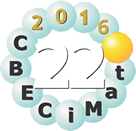

 |
Ricardo H.R. de Castro is an associate professor in the Department of Materials Science & Engineering at University of California, Davis. He joined UC Davis in 2009 and is the lead of the Nanoceramics Thermochemistry Laboratory (NTL), a laboratory dedicated to provide fundamental understanding, using experimental thermodynamics, of ceramic nanomaterials and their behavior under processing conditions and operation at extreme environments, such as high temperatures and radiation. Castro has a PhD in Metallurgical and Materials Engineering from the University of S~ao Paulo, Brazil, and a B.Sc. in Molecular Sciences. Castro received the 2014 Robert L. Coble Award by the American Ceramic Society, and the 2015 Global Young Investigator Award by the Engineering Ceramic Division among other important awards. |
Ricardo H.R. de Castro
Department of Materials Science & Engineering NEAT ORU, University of California, Davis, California
Resumo
Ceramics can exhibit unique physical and chemical properties when their feature size approaches nanometer dimensions. These properties have inspired a variety of applications in several fields and opened the development of solutions in response to current global challenges such as the increasing demand for energy. However, nanocrystalline materials are intrinsically unstable due to the excess energies coming from extensive surfaces or grain boundary areas. In this talk, we show how one may dramatically improve the stability of nanoceramics by targeting modifications on their thermodynamic properties, challenging old paradigms in the field that infer thermodynamics is irrelevant on the matter. Based on solid theoretical framework, we show that designed dopants prone to segregation to interfaces can lower their excess energies, increasing stability against coarsening and enabling the nanostructural features to survive high temperature processing and operational environments. By using highly-sensitive calorimetric techniques, we quantify the energetics of nanocrystalline ceramics and show that lowering surface energies can result in ultra-stable catalyst supports, while lowering grain boundary energies can result in grain growth inhibition even when exposing parts to extreme temperatures for prolonged times.